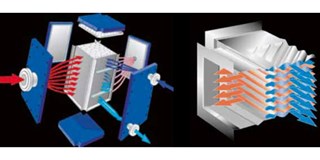^ Fig. 1: In the plate-and-frame heat exchanger, flow paths are countercurrent [Diagrams: Alfa Laval (Figures 1–5)].
Article By Jeff Kerner*
___
1. Corrugated plate technology
Corrugated plate technology is the concept behind two of the three types of CHEs covered in this article.
1.1 Plate heat exchangers
The first type is best known as plate-type heat exchangers (also called a plate-and-frame heat exchangers) as shown in Fig. 1.
Flow paths in plate heat exchangers are almost always truly countercurrent, maximizing the thermal driving force between hot and cold fluids. The fluids are contained in their flow path by elastomeric gaskets or, in the case of higher design-pressure plate heat exchangers, by brazing or fusion bonding instead of gaskets.
The corrugated surfaces of the plates create a large number of contact points, allowing the units to be built with rather thin heat transfer surfaces (0.4–0.8-mm thick), yet able to withstand high design pressures in excess of 20 barg for gasketed plate heat exchangers and up to 54 barg for brazed and for fused plate heat exchangers.
The corrugated plates have rather shallow pressing depths (2–4 mm and, in special designs, up to 16 mm) that create a turbulent path for fluid flow (Fig. 2), generating high wallshear stress, often at relatively low channel velocities.
Wall shear stress is an important factor in mitigating fouling. The plate and frame heat exchanger has been shown to demonstrate much higher heat transfer coefficients than conventional shell and tube exchangers and has been discussed before (see ‘Plate Heat Exchangers: Avoiding Common Misconceptions and Improving Heat Revovery,’ Chem. Eng., February 2009, pp. 40–47).
1.2. Fluted-plate block heat exchangers
Another type of heat exchanger based on corrugated plate technology is known as the fluted-plate block heat exchanger. This design is similar to the plate-and-frame type discussed earlier in that each consists of stamped, corrugated plates. However, in the fluted plate block heat exchanger, the two media flow in alternately welded (not gasketed) channels between the plates. The flow pattern is cross-flow within each pass. Due to the shorter length of each plate than found in a plate heat exchanger, the fluted-plate block heat exchanger may require multiple passes, although the resulting, overall flow arrangement between hot and cold media is almost always countercurrent (Fig. 3).
Four heavy steel panels surround the plate pack. Each pass is separated from the adjacent passes by a baffle, which forces the fluid to turn between the plate pack and the panel. As in the plate type heat exchanger discussed previously, the corrugated plates in the fluted-plate block heat exchanger create narrow channels for each fluid. These narrow channels generate turbulence, resulting in high film coefficients and high wall-shear stress, typical of corrugated plates with narrow channel spacings. Both the plate type and the fluted-plate block heat exchanger are characterized by small residence times due to their relatively low holdup volumes.
2. Spiral heat exchangers
The third type of heat exchanger in the class of CHEs to be discussed is the spiral heat exchanger. Unlike the plate-type heat exchanger and the fluted-plate block heat exchanger, the heat transfer surfaces of the spiral heat exchanger are not corrugated plates. Instead, the surfaces are sheets of steel (or any alloy that can be cold-worked and welded) wound around a center tube, which is then wound so that two separate, concentric channels are formed (Fig. 4).
Uniform spacing between the wound passages is maintained along the length of the spiral winding by spacer studs that are welded to one of the sheets. Most manufacturers offer spacings of 6–25 mm. Both of the fluid flow channels are closed by alternate channels welded at each side of the spiral sheet.
While the spiral can be configured into a number of flow patterns that result in spiral flow on both sides, spiral flow on one side and cross-flow on the other side, or a combination of spiral flow and cross flow (for condensing and subsequent sub-cooling), this article discusses those spiral configurations where one or both fluids are in spiral flow, since this is the design most often used in liquid-liquid applications.
The spiral heat exchanger does not contain the parallel flow passages found in the corrugated plate types discussed above nor in the tube channels of a shell and tube. Instead, the spiral has a unique self-scrubbing feature due to the fact that the fluid (or both fluids) are in a single flow passage. That is, the fluid, upon entering the spiral heat exchanger, does not have the possibility of dividing up into a number of parallel flow paths as it can in the plate heat exchanger, fluted-plate block heat exchanger or tube bundle of a shell-and- tube heat exchanger.
Once the fluid enters the spiral channel, it must continue through that same cross-sectional area for flow until it exits the heat exchanger. As a result of this continuous, curving passage for flow, any solids that build up in the channel constrict the cross-sectional area for flow at that point, and as long as there is enough dead head in the pump feeding the fluid through that channel, the local velocity at the point of build-up increases as the local cross-sectional area decreases.
The self-scrubbing feature is most effective, especially due to sedimentation of particulate matter, when the axis of the spiral channel is horizontal. In this configuration, the spiral is especially effective for handling fluids with high concentrations of suspended solids. In a spiral heat exchanger, both fluids are usually considered to be in nearly pure countercurrent flow.
*This article was first published by: Jennings Alberts Inc. Edited by Gerald Ondrey, CE Chemical Engineering






